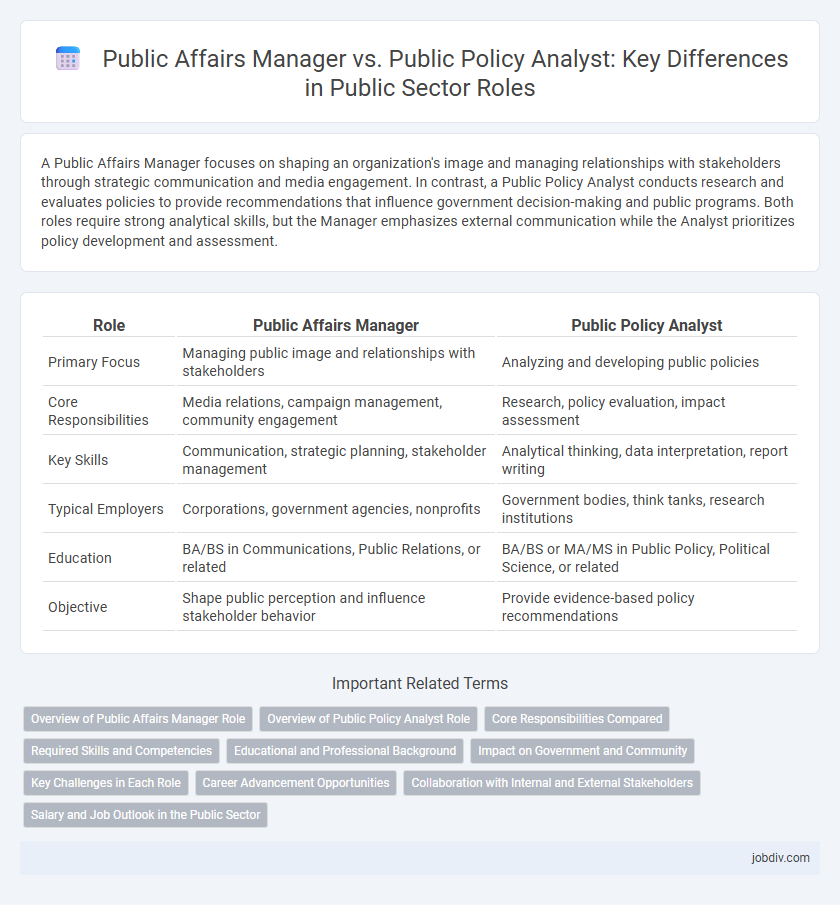A Public Affairs Manager focuses on shaping an organization's image and managing relationships with stakeholders through strategic communication and media engagement. In contrast, a Public Policy Analyst conducts research and evaluates policies to provide recommendations that influence government decision-making and public programs. Both roles require strong analytical skills, but the Manager emphasizes external communication while the Analyst prioritizes policy development and assessment.
Table of Comparison
| Role | Public Affairs Manager | Public Policy Analyst |
|---|---|---|
| Primary Focus | Managing public image and relationships with stakeholders | Analyzing and developing public policies |
| Core Responsibilities | Media relations, campaign management, community engagement | Research, policy evaluation, impact assessment |
| Key Skills | Communication, strategic planning, stakeholder management | Analytical thinking, data interpretation, report writing |
| Typical Employers | Corporations, government agencies, nonprofits | Government bodies, think tanks, research institutions |
| Education | BA/BS in Communications, Public Relations, or related | BA/BS or MA/MS in Public Policy, Political Science, or related |
| Objective | Shape public perception and influence stakeholder behavior | Provide evidence-based policy recommendations |
Overview of Public Affairs Manager Role
A Public Affairs Manager oversees communication strategies to shape public perception and influence policy decisions, often acting as a liaison between organizations and government entities. They manage media relations, coordinate advocacy campaigns, and monitor legislative developments to align organizational goals with public interests. Their role requires strong skills in stakeholder engagement, strategic planning, and crisis communication to effectively navigate political and social landscapes.
Overview of Public Policy Analyst Role
Public Policy Analysts conduct in-depth research and evaluate the impact of existing and proposed policies using data-driven methods to inform decision-making processes. They prepare detailed reports, conduct stakeholder analyses, and recommend policy options to government agencies, think tanks, or advocacy groups. Their expertise in interpreting legislative frameworks and socioeconomic data guides the development of effective, evidence-based public policies.
Core Responsibilities Compared
A Public Affairs Manager primarily develops and implements communication strategies to manage an organization's public image and stakeholder relationships, while a Public Policy Analyst conducts in-depth research and analysis of policies to provide evidence-based recommendations for decision-making. Public Affairs Managers engage with media, government officials, and the public to influence opinion and legislative outcomes, whereas Public Policy Analysts focus on evaluating policy impacts, economic trends, and social factors to inform policy formulation and reform. Both roles require strong understanding of political environments and regulatory frameworks but differ in their operational focus on communication versus analytical policy assessment.
Required Skills and Competencies
Public Affairs Managers require strong communication, strategic planning, and stakeholder engagement skills to effectively manage organizational reputation and influence public opinion. Public Policy Analysts emphasize analytical thinking, research proficiency, and data interpretation abilities to evaluate policies and advise decision-makers. Both roles demand expertise in government relations, but Public Affairs Managers focus more on relationship-building, while Public Policy Analysts concentrate on evidence-based policy assessment.
Educational and Professional Background
A Public Affairs Manager typically holds a bachelor's degree in public relations, communications, or political science, often complemented by several years of experience in media relations or corporate communications. In contrast, a Public Policy Analyst generally possesses a master's degree in public policy, political science, economics, or a related field, with strong analytical skills and experience in research and data interpretation. Professional certifications in public affairs or policy analysis can enhance credentials for both roles, but the Public Policy Analyst emphasizes quantitative and qualitative research expertise.
Impact on Government and Community
Public Affairs Managers influence government by shaping public opinion, managing communication strategies, and fostering relationships between organizations and policymakers to drive community engagement. Public Policy Analysts provide in-depth research, evaluate policy options, and offer data-driven recommendations that guide legislative decisions and public programs. Both roles significantly impact government effectiveness and community well-being but operate at different stages of policymaking and stakeholder interaction.
Key Challenges in Each Role
Public Affairs Managers face the key challenge of managing stakeholder relationships and mitigating reputational risks while navigating complex media landscapes and public opinion fluctuations. Public Policy Analysts encounter difficulties in accurately interpreting legislative developments and forecasting policy impacts amidst rapidly changing political environments and competing interest groups. Both roles demand strategic communication and critical analysis, yet Public Affairs Managers emphasize external engagement, whereas Public Policy Analysts focus on evidence-based policy evaluation.
Career Advancement Opportunities
Public Affairs Managers often experience faster career advancement through leadership roles in corporate communications, government relations, and strategic advocacy, benefiting from direct engagement with stakeholders and media. Public Policy Analysts typically progress by deepening subject-matter expertise and influencing legislative processes, with opportunities to transition into advisory positions or policy development leadership. Both careers demand strong analytical, communication, and networking skills, but Public Affairs Management usually offers broader managerial and executive pathway options.
Collaboration with Internal and External Stakeholders
Public Affairs Managers excel in fostering collaboration by coordinating communication strategies between organizations and external stakeholders such as government agencies, media, and community groups. Public Policy Analysts focus on working closely with internal teams and external experts to gather data, analyze policy impacts, and provide evidence-based recommendations that shape organizational decision-making. Both roles require strong interpersonal skills and the ability to balance diverse stakeholder interests to effectively influence public outcomes.
Salary and Job Outlook in the Public Sector
Public Affairs Managers in the public sector typically earn salaries ranging from $65,000 to $110,000 annually, with job growth projected at 7% over the next decade. Public Policy Analysts, meanwhile, have average salaries between $60,000 and $100,000, with a slightly faster job outlook growth of approximately 8%. Both roles offer competitive pay and steady demand, reflecting their critical influence on government operations and policy development.
Public Affairs Manager vs Public Policy Analyst Infographic

 jobdiv.com
jobdiv.com